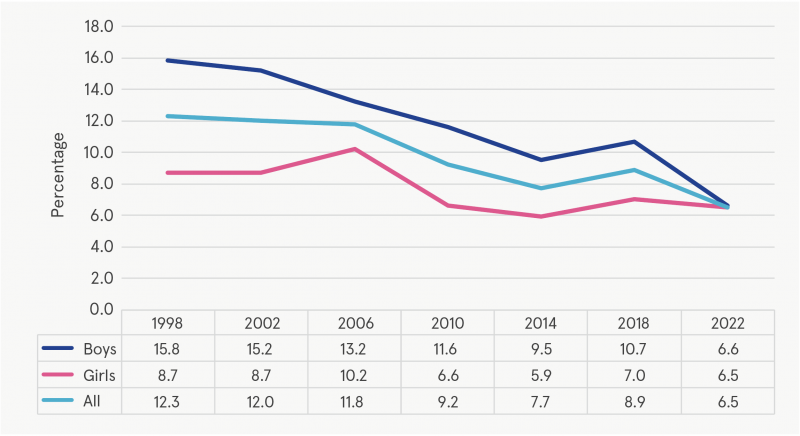Millar, Seán  ORCID: https://orcid.org/0000-0003-4453-8446
(2025)
Cannabis use findings from the Health Behaviour in School-aged Children study, 2022.
Drugnet Ireland,
Issue 92, Autumn 2025, Supplement,
pp. 17-19.
ORCID: https://orcid.org/0000-0003-4453-8446
(2025)
Cannabis use findings from the Health Behaviour in School-aged Children study, 2022.
Drugnet Ireland,
Issue 92, Autumn 2025, Supplement,
pp. 17-19.
| Preview | Title | Contact |
|---|---|---|
|
PDF (Drugnet Ireland 92, supplement)
970kB |
The first Health Behaviour in School-aged Children (HBSC) study was conducted in Ireland in 1998 and has been repeated every 4 years ever since. In 2022, Ireland participated in the HBSC study for the seventh time. The survey included a representative sample of 9,071 children drawn from primary and post-primary schools across Ireland; 191 schools participated. Data were collected on general health, smoking, use of alcohol and other substances, food and dietary behaviour, exercise and physical activity, self-care, injuries, bullying, and sexual health behaviours. The main results were published in 2025.1 This article describes results pertaining to the use of cannabis and makes comparisons with previous HBSC studies.
Cannabis use in the last year
Overall, 6.5% of 10–17-year-olds said that they had used cannabis in the last year. The prevalence of cannabis use increased with age, and a higher percentage of boys aged 10–14 years reported using cannabis compared with girls (see Table 1). Almost 13% of boys and 13.4% of girls aged 15–17 years reported having used cannabis in the last year.
Table 1: Percentage of 10–17-year-olds reporting cannabis use in the last year, by sex and age group, 2022

Source: HBSC Ireland (2025)

Figure 1: Percentage of 10–17-year-olds who reported cannabis use in the last 12 months, overall and by sex, from 1998 to 2022
Source: HBSC Ireland (2022)Trends in cannabis use among Irish school-aged children, 1998–2022
Although a higher percentage of 10–17-year-olds reported having used cannabis in 2018 compared with the 2014 HBSC study (see Figure 1), there has been a steady decrease in the lifetime use of cannabis among school-aged children since 1998, with data from 2022 indicating an 82.1% reduction among boys and a 28.9% reduction among girls.
It is worth noting that these findings are from the first HBSC Ireland study conducted since the start of the COVID-19 pandemic. Data were collected during a time when schools had recently reopened and when young people were readjusting following long periods of school closures and remote learning. Consequently, these findings should be interpreted with this specific historical time frame in mind, considering the impacts of recent COVID-19 pandemic measures on young people’s lives.
1 Gavin A, Kolto A, Lunney L, et al. (2024) The Irish Health Behaviour in School-aged Children (HBSC) Study 2022. Galway: Department of Health and University of Galway. Available from: https://www.drugsandalcohol.ie/40947/
B Substances > Cannabis / Marijuana
T Demographic characteristics > Child / children
T Demographic characteristics > Adolescent / youth (teenager / young person)
T Demographic characteristics > Gender / sex differences
VA Geographic area > Europe > Ireland
Repository Staff Only: item control page